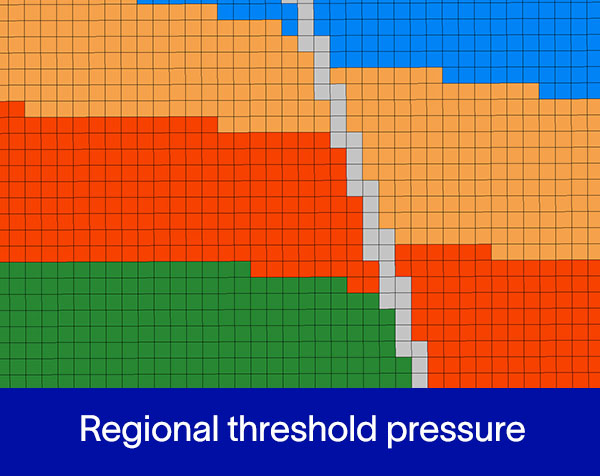Release highlights
Physics, CO2 storage capabilities, performance, field management, and usability form the core pillars of the Intersect™ high-resolution reservoir simulator. The release of the 2024.2 package delivers key features and updates reflecting these key focus areas.
Faster and more stable geomechanical coupled simulations for carbon storage and more!
A new direct coupling workflow for carbon storage and geomechanics simulations is now available using Intersect simulator and Visage™ finite-element geomechanics simulator.
It can now process models up to 15-times faster in models tested, is more stable, and can handle models that were unfeasible to run before. The new workflow is fully supported by the Petrel™ subsurface software and can be launched on premises or in the cloud.

Image showing the impact of CO2 injection modelling on the geomechanics properties of rock-direct coupling using Intersect and Visage simulators (Data Courtesy: Illinois State Geological Survey (ISGS), Illinois Basin - Decatur Project (IBDP) CO2 Injection Monitoring Data, April 30, 2021. Midwest Geological Sequestration Consortium (MGSC) Phase III Data Sets. DOE Cooperative Agreement No. DE-FC26-05NT42588)
More functionality added to the multiscale sequential fully implicit method for improved performance
The multiscale sequential fully implicit (SFI) method can now support threshold pressure modeling which specifies a threshold for the pressure difference between areas in the reservoir and is useful for modeling large heterogenous models and scenarios, such as imposing initial hydraulic equilibrium between communicating independent regions.
Threshold pressure modelling using the multiscale SFI method is observed to be up to three (3) times faster in tested models than the fully implicit method.

Image showing threshold pressure modeling using the multiscale SFI method
Spycher and Pruess CO2 solubility model extended to include additional components!
The Spycher and Pruess solubility model can now be combined with custom tables for other components such as H2S allowing impurities to be modeled, improving the representativeness of carbon storage simulations.

Plus, many more additional features!
Learn more about Intersect™ high-resolution reservoir simulator
Key Enhancements
Physics and CO2 storage
-
The ThreePhaseComponentAdjustment field has been added to the PostInitializationFlash node for use in enumerated cases. It adjusts the composition of water in isothermal cases where hydrocarbon components such as CO2 are soluble in water, so that the aqueous phase is in thermodynamic equilibrium with the hydrocarbon phases
-
A new standard volume fraction weighted power-law viscosity mixing rule in thermal simulations is now available under the ViscosityMixingRule node, to assist in matching experimental data for fluid mixture viscosities such as bitumen and light hydrocarbons. To calculate the weighting factors based on component volume fractions at standard conditions, set the new PowerMixingWeighting field to STANDARD_VOLUME_FRACTION
-
You can now choose between harmonic average calculation and upstream weighted calculation (default) for the solid mobility multiplier for use in the flux calculation. This is selected in the new CalculationMethod field under the SolidMobilityMultiplier node. The harmonic average calculation method is particularly relevant for injection studies with significant levels of salt precipitation
-
A new property set named CO2STORE has been added to the XYPlotSummaryReport and Recurrent3DReport nodes. CO2STORE includes commonly requested field, well, and 3D properties in CO2 storage cases. For efficiency, the component-based properties are only reported for components that are soluble in water
-
Six new summary vectors related to component mass have been created to support workflows where tracking specific brines is of importance, such as with the recovery of critical minerals. The vectors are available at field, group, and well level
-
Reporting of the adsorbed mass of a specific hydrocarbon component can now be requested using the ADSORBED_COMPONENT_MASS property as a 3D property (under Recurrent3DReport) and a summary vector (under GridCellProperties)
Field management and usability
-
New field-level summary vectors to track material balance error have been added to the XYPlotSummaryReport node. You can use MATERIAL_BALANCE_ERROR to report material balance error normalized by total moles and MATERIAL_BALANCE_ERROR_COMPONENT_NORM to report material balance error normalized by component moles. The latter is suitable for problems where the ratio of moles per component of interest to the total moles in place is very small, such as when foreign components are injected into a reservoir.
-
The initial state of the reservoir (pressure and phase saturations) can now be reported as recurrent properties and stored for use in expressions. This enables you to create custom calculations that refer to those initial properties: for example, the pressure difference at a report step in relation to its initial value. A new field called StoredInitialProperties under the ReportMgr node specifies which initial properties to store and use during the simulation.
